|
|
ASTROTEOLOGIA-EVANGELIO EN LAS ESTRELLAS: NGC 6543 OJO DE GATO
Choisir un autre rubrique de messages |
|
Réponse |
Message 1 de 139 de ce thème |
|
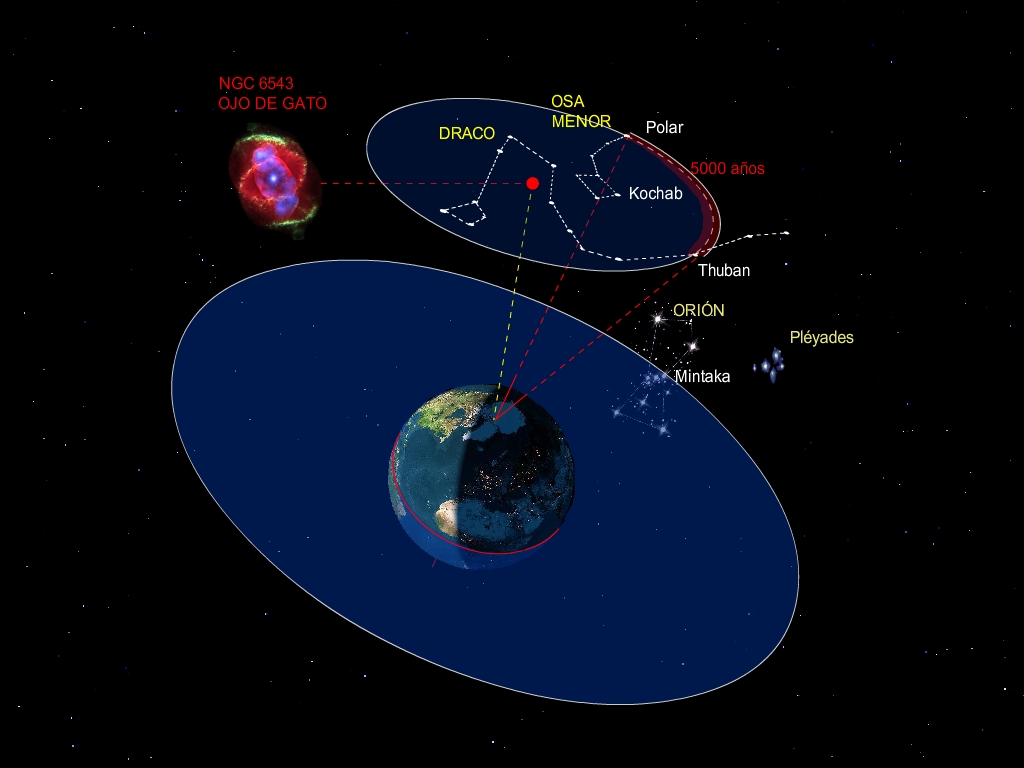
Nebulosa Ojo de Gato
De Wikipedia, la enciclopedia libre
La nebulosa Ojo de Gato (NGC 6543) es una nebulosa planetaria en la constelación del Dragón. Estructuralmente es una de las nebulosas más complejas conocidas, en la que las imágenes de muy alta resolución del Telescopio Espacial Hubble han mostrado notables estructuras como nudos, chorros de material, burbujas y estructuras en forma de arco.
Fue descubierta por William Herschel el 15 de febrero de 1786 y fue la primera nebulosa planetaria cuyo espectro fue investigado, siendo esta labor realizada por el astrónomo William Huggins en 1864.
Los estudios modernos revelan una naturaleza compleja con intrincadas estructuras que podrían estar causadas por material eyectado por una binaria acompañando a la estrella central. Sin embargo no hay evidencias directas de la presencia de dicha compañera estelar. Además las medidas de las abundancias de elementos químicos obtenidas por diferentes métodos presentan una importante discrepancia entre sí, indicando que hay aspectos de esta nebulosa que permanecen todavía sin ser comprendidos.
Información general
NGC 6543 es una nebulosa planetaria muy estudiada. Es relativamente brillante con una magnitud aparente de 8.1, y también con una temperatura de brillo poco estructural elevada. Se encuentra en las coordenadas de ascensión recta 17h 58.6m y declinación +66°38'. La alta declinación significa que es fácilmente observable desde el hemisferio norte, donde la mayoría de los grandes telescopios han sido construidos. Curiosamente se halla en el polo N de la eclíptica del Sistema Solar, por lo que las representaciones que muestran cómo se vería éste desde "arriba" muestran cómo se vería desde allí[5]
Mientras que la nebulosa interior más brillante tiene un tamaño relativamente reducido de 20 segundos de arco de diámetro, posee un halo extenso con material eyectado de la estrella central durante la etapa de gigante roja. El halo se extiende unos 386 segundos de arco (6,4 minutos de arco).
Las observaciones muestran que el cuerpo principal de la nebulosa tiene una densidad de unas 5000 partículas/cm³ y una temperatura de 8.000 K 1. El halo exterior tiene una temperatura algo superior de 15.000 K y una densidad muy inferior.
La estrella central en NGC 6543 es una estrella de tipo espectral O con una temperatura en la fotosfera de 80.000 K. Su brillo es aproximadamente 10.000 veces más luminosa que el Sol con un radio de 0,65 el radio solar. Diversos análisis espectroscópicos muestran que la estrella pierde masa rápidamente por un fuerte viento estelar a un ritmo de 3,2×10−7 masas solares por año - 20 trillones de t/s. La velocidad de este viento de partículas es de 1900 km/s. Los cálculos y modelos teóricos indican que la estrella central posee actualmente una masa solar pero los cálculos de su evolución teórica implican una masa inicial de 5 masas solares2.
[editar] Observaciones
Mediante prismáticos de 9x63, con un cielo de magnitud límite aproximada de +5,2, este objeto se puede observar con un ligero efecto de parpadeo y un punto con forma estelar, quizás algo desenfocado, como toda nebulosa planetaria.
Con unos prismáticos de 10x50 posee un aspecto de una estrella desenfocada, siempre bajo cielos limpios y sin polucionar.
[editar] Observaciones infrarrojas
Las observaciones de NGC 6543 en longitudes de onda infrarrojas muestran la presencia de una polvo estelar y gas a baja temperatura. Se piensa que el polvo se formó en las últimas fases de la vida de la estrella progenitora. Este polvo absorbe luz de la estrella central reemitiendo la energía en longitudes infrarrojas. El espectro de emisión infrarrojo permite deducir temperaturas de 70 K.
Las emisiones infrarrojas revelan la presencia de material no ionizado como hidrógeno molecular (H2). En muchas nebulosas planetarias la emisión molecular es mayor a distancias mayores de la estrella donde el material deja de estar ionizado. En el caso de NGC 6543 la emisión de hidrógeno es más intensa en el límite interior del halo exterior. Esto es posiblemente debido a ondas de choque excitando el H2 a medida que impactan a diferente velocidad con el halo.3
[editar] Observaciones ópticas y ultravioletas
NGC 6543 ha sido extensamente observada en el ultravioleta y en las longitudes de onda del visible. Las observaciones espectroscópicas en estas longitudes de onda permiten determinar las abundancias de diferentes especies químicas, así como intrincadas estructuras de la nebulosa.
La imagen en falso color del HST resalta las regiones de alta y baja concentración de iones. Tres imágenes fueron tomadas en filtros que aislaban la luz emitida por iones de hidrógeno en 656.3 nm, nitrógeno ionizada en 658.4 nm y oxígeno doblemente ionizado en 500.7 nm. Las imágenes fueron combinadas en canales rojo, verde y azul respectivamente. La imagen revela dos capas de material menos ionizado en los límites de la nebulosa.
[editar] Observaciones en rayos X
El Observatorio de rayos X Chandra ha revelado la presencia de gas extremadamente caliente alrededor de NGC 6543. Se cree que el gas caliente es producido por la violenta interacción entre el viento estelar y el material expulsado anteriormente. Esta interacción ha vaciado en gran medida el interior de la nebulosa dejando un espacio menos denso en forma de burbuja.
Las observaciones de Chandra han revelado también una fuente puntual de intensos rayos X en la posición de la estrella. Ésta no debería emitir tan intensamente en esta longitud de onda por lo que el elevado flujo de rayos X resulta algo misteriosa. Una posibilidad interesante es que los rayos X podrían ser producidos en un hipotético disco de acreción alrededor del sistema binario4.
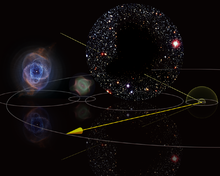
La expansión radial de NGC 6543 a lo largo de varios años puede ser utilizada para calcular su distancia.
Las distancias a las nebulosas planetarias no son tan fáciles de identificar como en el caso de algunas estrellas. Muchos de los métodos utilizados para estimar estas distancias se basan en hipótesis generales que pueden ser inadecuadas para el objeto específico bajo estudio.
El ritmo de expansión angular de la nebulosa puede ser utilizado para estimar la edad de ésta. Si la expansión ha procedido a ritmo constante, para alcanzar un diámetro de 20 segundos de arco a un ritmo de 10 milisegundos de arco por año, la nebulosa se habría formado hace unos 1000 años5. Probablemente esta edad es solo un límite superior ya que el material expulsado podría haberse desplazado a mayor velocidad en el pasado siendo frenado por su interacción con el medio interestelar.
[editar] Composición química

Imagen de NGC 6543 procesada fuertemente para mostrar estructuras en forma de anillo envolviendo la nebulosa central. También visibles son diversas estructuras lineales causas posiblemente por la precesión de chorros de eyección en el sistema binario.
Como la mayoría de los objetos astronómicos NGC 6543 está formada sobre todo por hidrógeno y helio, con elementos pesados tan solo presentes en pequeñas cantidades. La composición exacta puede ser estudiada mediante el análisis espectroscópico de la luz procedente de la nebulosa. Las abundancias se expresan generalmente relativas al hidrógeno, el elemento más abundante.
Diferentes estudios indican que la proporción de helio frente al hidrógeno en la nebulosa del Ojo de Gato es de 0.12, el carbono y el nitrógeno tienen abundancias de 3×10−4, y el oxígeno tiene una abundancia de 7×10−4. Estos valores son típicos dentro de las nebulosas planetarias con concentraciones de carbono, nitrógeno y oxígeno más abundantes que en una estrella como el Sol debido a los efectos de la nucleosíntesis que enriquece la atmósfera estelar en elementos pesados que son luego expulsados formando la nebulosa planetaria1,6.
El análisis más detallado muestra que la nebulosa contiene también una pequeña cantidad de material altamente enriquecido en elementos pesados.
[editar] Cinemática y morfología de la nebulosa
NGC 6543 es una nebulosa de gran complejidad estructural. Los mecanismos capaces de moldear todas sus formas no se comprenden con claridad. La porción más brillante interior está causada por la interacción del viento estelar con el material expulsado durante la formación de la nebulosa. En este proceso se emiten gran cantidad de rayos X. El viento estelar vacía de manera inhomogénea el interior de la nebulosa.7
Dado que la estrella central presenta signos de poder ser un sistema binario la interacción entre ambas estrellas contribuye también a moldear las estructuras interiores de la nebulosa. En este caso podría existir un disco de acreción con material fluyendo de una estrella a la otra y con fenómenos de eyección por las regiones polares de la estrella. Estos chorros de eyección estarían sometidos a movimientos de precesión que podría contribuir a formar las estructuras en forma de filamento presentes en la nebulosa.8
Más allá de la nebulosa interior el halo exterior envuelve el sistema en una serie de anillos concéntricos formados en etapas anteriores de la formación de la nebulosa planetaria, cuando la estrella interior estaba en la rama asintótica de las gigantes rojas del diagrama de Hertzsprung-Russell. Los anillos están uniformemente distribuidos por lo que tan solo habría un único mecanismo responsable de su formación a intervalos regulares.9 Más lejos todavía se puede apreciar un halo de material más tenue.
http://es.wikipedia.org/wiki/Nebulosa_Ojo_de_Gato
|
|
|
|
Réponse |
Message 125 de 139 de ce thème |
|

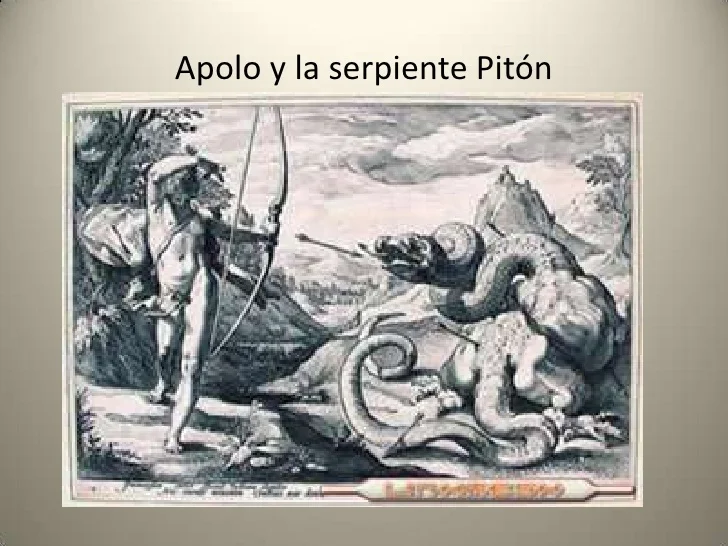
| Reply |
Message 7 of 7 on the subject |
|
|
VESICA PISCIS=JUAN 21:11 = SEXO MASCULINO (ULTRA SECRETO "MASONICO" DETRAS DE LA MISA CATOLICA)
|
| Reply |
Message 61 of 61 on the subject |
|
  Las piedras de estaciones de Stonehenge forman un rectángulo con la proporción de 5:12 - Mapa con Stonehenge y la isla Caldey mostrando la distancia proporcional de 12,369 - eso es el número de lunas llenas por año Las piedras de estaciones de Stonehenge forman un rectángulo con la proporción de 5:12 - Mapa con Stonehenge y la isla Caldey mostrando la distancia proporcional de 12,369 - eso es el número de lunas llenas por año
5. Stonehenge - geometría secreta - triángulo de 5:12, estrella de 7 puntos, número 1234, Stonehenge+isla Lundy -- Nueva York con un triángulo en el Parque Central como Stonehenge tiene -- Stonehenge: la proporción original de 5:12 -- Stonehenge: William Stukeley y druidas para la francmasonería -- Stonehenge: una estrella de 7 puntos e Isis -- Distancias: Stonehenge - Averbury - la colina de Silbury -- Stonehenge, monumento de Averbury y el monumento de Silbury - números con sol, luna y el cubo de Isis -- Stonehenge y su cantera en las montañas Preseli en Gales apr. 130 millas en el oeste -- El número 1234: Stonehenge - isla Lundy 123,4 millas -- Triángulo Stonehenge - cantera de Preseli - isla Lundy: 5:12 -- Copias de Stonehenge en el mundo - francmasones e iluminados criminales ponen sus símbolos de poder - p.e. en Lima en el Perú -- Hay una copia de Stonehenge en el centro de Lima en el parque de fontanas (parque de la reserva) -- 6. Milla y pies y luna y Tierra - números 3456, 108, 528 -- La milla y Stonehenge: 108 millas reales = 123,4 millas internacionales -- Número 108: Tierra, religiones, luna etc. -- Luna y número 108: radio 1080 millas reales -- Pie y Tierra: 360 grados x 365,242 días x pie x 1.000 = circunferencia de la Tierra -- Milla y Tierra: 12 elevado 5 dividido por 10 millas = circunferencia de la Tierra -- El pie inglés es el origen del sistema antiguo de mediciones -- 7. Stonehenge, la cantera y las islas 5:12 - Newton y su número 33 -- Stonehenge: isla Lundy + isla Caldey: 3:2 - Stonehenge-isla Caldey=12,369 = número de lunas llenas por año -- Newton: su escala de temperatura y el número 33
|
|
|
|
|
|
|
|
Réponse |
Message 126 de 139 de ce thème |
|
|
CONEXION DEL RADIO POLAR EN MILLAS REALES CON LA CONSTELACION "OJOS DE GATO". NGC 6543 ES UN ANAGRAMA DEL RADIO POLAR EN MILLAS REALES 3456.
| Reply |
Message 25 of 29 on the subject |
|
|
|
|
|
|
|
|
Réponse |
Message 127 de 139 de ce thème |
|
|
|
|
Réponse |
Message 128 de 139 de ce thème |
|
| rom: Cajeli (Original message) |
Sent: 03/09/2017 20:30 |
|
LA TORRE DE MAGDALA
De María Magdalena se cree que su nombre indica que ella pertenecía a la ciudad de Magdala, del hebreo migdál que significa “ciudad de las torres”, la cual ha querido ser asociada con un puerto pesquero, aledaño a una región donde proliferaban los burdeles.
Su fama de prostituta se origina cuando la iglesia católica la quiso identificar con la mujer pecadora que ungió con perfumes a Jesús, en la casa de Simón el fariseo; sin embargo el pasaje de Lucas 7.36-50 donde se registra este hecho, no da el nombre de la mujer a quien Jesús le perdona sus pecados, ni mencionan los 7 demonios de los que Jesús libró a la Magdalena.
Aunque en el Evangelio no se dice que ella fuera viuda o casada, tampoco se dice que fuera soltera, o una prostituta. Estuvo relacionada con mujeres importantes como la esposa del intendente de Herodes, y ayudó a financiar con sus bienes el ministerio de Jesús. Teniendo en cuenta que migdal significa torre, el nombre de María Magdalena la muestra como mujer vigilante, como una atalaya.
Precisamente esta mujer permaneció atenta a todos los acontecimientos durante el ministerio de Jesús; estuvo presente “mirando de lejos” la crucifixión del Señor, junto con el grupo de mujeres que lideraba; fue ella quien vio el lugar donde Jesús era puesto luego de morir. También fue quien vio quitada la piedra del sepulcro el primer día de la semana; y fue quien primero vio a Jesús resucitado, y salió apresurada para anunciar las Buenas Nuevas.
Con su don especial de permanecer atenta, se asemeja a las cinco vírgenes sensatas que manutuvieron aprovisionadas sus lámparas hasta la llegada del Novio. La bendigo, y reconozco que la iglesia de Jesucristo necesita Atalayas como esta mujer, la cual representa a la iglesia fiel y vigilante que será la esposa del Cordero

|
 First First  Previous 2 to 12 of 12 Next Previous 2 to 12 of 12 Next  Last Last  |
| Reply |
Message 2 of 12 on the subject |
|
| From: Rolmen |
Sent: 03/09/2017 22:32 |
|
Muy bonito cuento, ¿Quién es el autor? Quizá Wilde, o tal vez Andersen, o Dumas? O sería el judío Raigorodsky? Qué sé yo, pero el cuento es fascinante, sobretodo, en la parte narrativa en la cual especifica que estuvo, María Magdalena, presente en muchos acontecimientos y me pregunto, de que viviría esa mujer que tenía espacio de tiempo para estar de fisgona, de verdad que se las inventan para tener entretenidos a los lectores creyentes de fábulas y la iglesia católica no pierde tiempo, la declara santa para seguir agregando adeptos y claro, digo esto esperando no ofender a nadie.
|
|
|
| Reply |
Message 3 of 12 on the subject |
|
| From: Cajeli |
Sent: 03/09/2017 22:43 |
|
La historia en realidad es algo más profunda.
María Magdalena era una mujer muy joven que cuidaban sus padres sabiendo que estaba endemoniada.
Sufría de neurosis y epilepsia, de esa manera se reflejaba su enfermedad espiritual, y por esto fue sanada por Jesús. No hay bases para afirmar que era prostituta, eso fue una enseñanza falsa, o mal entendido desde que en un sermón al Papa Gregorio I se le ocurrió decir que fue la mujer pecadora que ungió a Jesús con perfumes
|
|
|
| Reply |
Message 4 of 12 on the subject |
|
| From: Rolmen |
Sent: 04/09/2017 00:26 |
|
Bueno Cajeli, real o no, es irrelevante, pero si, creo es una fantasía, es como tú mismo afirmas que el tal Gregorio I se le ocurrió que dicho personaje era una trabajadora sexual, bien pudo este sujeto u otro crear o tergiversar historias que luego, repetidas una y mil veces, con el tiempo se dan como verídicas, hay quienes afirman que esta mujer fue amante de Jesús Cristo e incluso tuvo vástagos de esa relación y no lo afirmo yo, sino está en boca de mucha gente y por ello te digo que las historias están trabucadas.
|
|
|
Esta es otra región de Marte, Cydonia Mensae a 33ºN y 13ºW
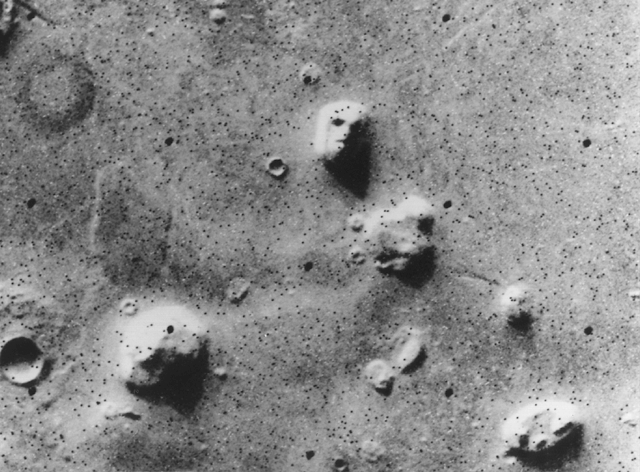
sidon esta en el paralelo 33
CYDONIA EN MARTE Y EL 33
| Reply |
Message 5 of 12 on the subject |
|
| From: Cajeli |
Sent: 04/09/2017 00:32 |
|
Este pasaje puede relacionarse con María Magdalena...
MATEO
15:21 Saliendo Jesús de allí, se FUE A LA REGIÓN DE TIRO Y SIDÓN.
15:22 Y he aquí una mujer cananea que había salido de aquella región clamaba, diciéndole: ¡Señor, Hijo de David, ten misericordia de mí! Mi hija es gravemente atormentada por un demonio.
15:23 Pero Jesús no le respondió palabra. Entonces acercándose sus discípulos, le rogaron, diciendo: Despídela, pues da voces tras nosotros.
15:24 El respondiendo, dijo: No soy enviado sino a las ovejas perdidas de la casa de Israel.
15:25 Entonces ella vino y se postró ante él, diciendo: ¡Señor, socórreme!
15:26 Respondiendo él, dijo: No está bien tomar el pan de los hijos, y echarlo a los perrillos.
15:27 Y ella dijo: Sí, Señor; pero aun los perrillos comen de las migajas que caen de la mesa de sus amos.
15:28 Entonces respondiendo Jesús, dijo: Oh mujer, grande es tu fe; hágase contigo como quieres. Y su hija fue sanada desde aquella hora.
15:29 Pasó Jesús de allí y vino junto al mar de Galilea; y subiendo al monte, se sentó allí.
15:30 Y se le acercó mucha gente que traía consigo a cojos, ciegos, mudos, mancos, y otros muchos enfermos; y los pusieron a los pies de Jesús, y los sanó;
15:31 de manera que la multitud se maravillaba, viendo a los mudos hablar, a los mancos sanados, a los cojos andar, y a los ciegos ver; y glorificaban al Dios de Israel.
15:32 Y Jesús, llamando a sus discípulos, dijo: Tengo compasión de la gente, porque ya hace tres días que están conmigo, y no tienen qué comer; y enviarlos en ayunas no quiero, no sea que desmayen en el camino.
15:33 Entonces sus discípulos le dijeron: ¿De dónde tenemos nosotros tantos panes en el desierto, para saciar a una multitud tan grande?
15:34 Jesús les dijo: ¿Cuántos panes tenéis? Y ellos dijeron: Siete, y unos pocos pececillos.
15:35 Y mandó a la multitud que se recostase en tierra.
15:36 Y tomando los siete panes y los peces, dio gracias, los partió y dio a sus discípulos, y los discípulos a la multitud.
15:37 Y comieron todos, y se saciaron; y recogieron lo que sobró de los pedazos, siete canastas llenas.
15:38 Y eran los que habían comido, cuatro mil hombres, sin contar las mujeres y los niños.
15:39 Entonces, despedida la gente, entró en la barca, y vino a la región de Magdala.
SIRIO ES LA CONSTELACION DEL PERRO/ CAN MAYOR
NOTEN EL NEXO DE DAN, CON LA SERPIENTE (VENECIA) Y EL CABALLO (PLAZA SAN MARCOS)
7. Génesis 49:17 Será Dan SERPIENTE junto al camino, Víbora junto a la senda, Que muerde los talones del caballo, Y hace caer hacia atrás al jinete.
VENECIA=PLAZA SAN MARCOS
11. Proverbios 25:11 MANZANA de oro con figuras de plata Es la palabra dicha como conviene.
12. Cantares 2:5 Sustentadme con pasas, confortadme con MANZANAs; Porque estoy enferma de amor.
13. Cantares 7:8 Yo dije: Subiré a la palmera, Asiré sus ramas. Deja que tus pechos sean como racimos de vid, Y el olor de tu boca como de MANZANAs,
ALLI ESTA LA CONEXION VENUS / VENECIA CON EL 666
VENUS= PENTAGONO= VENECIA= NUMERO DE ORO= 1.618033
LAS MATEMATICAS SON EXACTAS.
GLORIA A DIOS TODOPODEROSO. QUE BELLAS SON LAS MATEMATICAS
|
|
|
|
|
|
Réponse |
Message 129 de 139 de ce thème |
|
EUGENE ANDREW CERNAN=3/14=3.14=PI
ALAN LAVERNE BEAN=15/3 =VESICA PISCIS (MISA CATOLICA=JUAN 21:11)=DIA DE SAN LONGINO
JOHN WATTS YOUNG=24/9= DIA DE LA BATALLA DE TUCUMAN (DIA DE LA VIRGEN)/ ARGENTINA
. Juan 16:21 La mujer cuando da a luz, tiene dolor, porque ha llegado su HORA; pero después que ha dado a luz un niño, ya no se acuerda de la angustia, por el gozo de que haya nacido un hombre en el mundo.
|
|
|
|
Réponse |
Message 130 de 139 de ce thème |
|
|
|
|
Réponse |
Message 131 de 139 de ce thème |
|

11 DE SEPTIEMBRE O SEPTIEMBRE 11
11/9 O 9/11
Sapientia Aedificavit Sibi Domum. Es decir, "la sabiduría ha edificado aquí su casa". Resulta curioso que la misma frase aparece en el Evangelio de María Magdalena, un texto apócrifo. Se dice que en el interior de esta iglesia y de otras muchas de Venecia está escondido el tesoro de los templarios. Pero no hay ninguna prueba de ello. Para terminar ya con esta entrada me gustaría que nos acercásemos un momento a uno de los edificios más emblemáticos de Venecia: el Palacio Ducal.

La Maddalena

La Maddalena

ISLA SAN GIORGIO (VENECIA)=GEORGE LEMAITRE
GEMATRIA EN INGLES DE SEED=33
GEMATRIA EN INGLES DE GATE=33
SARA (CE-SAREA DE FILIPO)=PARALELO 33
"¡Oh profundidad de las riquezas de la sabiduría (sophia)
y de la ciencia (gnwsiV, gnosis) de Dios!
¡Cuán incomprensibles son sus juicios, e inescrutables sus caminos!"
(Romanos, 11: 33).
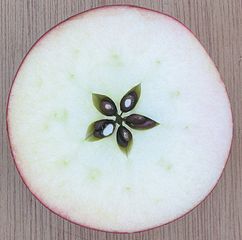 the Apple
| milky way in Simple Gematria Equals: 119 |
( |
m 13 |
i9 |
l 12 |
k 11 |
y 25 |
0 |
w 23 |
a1 |
y 25 |
) |
| queen mary in Simple Gematria Equals: 119 |
( |
q 17 |
u 21 |
e5 |
e5 |
n 14 |
0 |
m 13 |
a1 |
r 18 |
y 25 |
|
| hebrew calendar in Simple Gematria Equals: 119 |
( |
h8 |
e5 |
b2 |
r 18 |
e5 |
w 23 |
0 |
c3 |
a1 |
l 12 |
e5 |
n 14 |
d4 |
a1 |
r 18 |
| mary magdalene in Simple Gematria Equals: 119 |
( |
m 13 |
a1 |
r 18 |
y 25 |
0 |
m 13 |
a1 |
g7 |
d4 |
a1 |
l 12 |
e5 |
n 14 |
e5 |
|

|
|
|
|
Réponse |
Message 132 de 139 de ce thème |
|
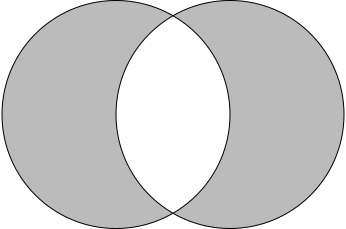 Vesica piscis Vesica piscisTAURO/TORO/PLEYADES/7 COLINAS DEL VATICANO
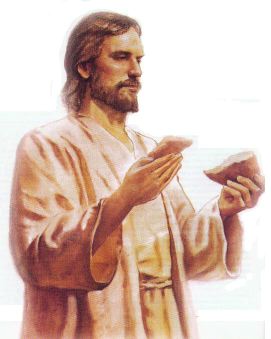 Fermentation - nigredo - bread and wine of Christ 
31 mar. 2017 - Subido por Videos Diario Financiero
Te invitamos a conocer las oficinas de Netflix en Los Gatos, California. Videos Diario Financiero. Loading ...
12 nov. 2013 - Subido por Claus Bülow Christensen
We have been visiting in Los Gatos with Netflix, which opened up for their daily locations where approx. 1000 ...
|
|
|
|
Réponse |
Message 133 de 139 de ce thème |
|
|
|
|
Réponse |
Message 134 de 139 de ce thème |
|
 Vesica piscis Vesica piscisTAURO/TORO/PLEYADES/7 COLINAS DEL VATICANO
 Fermentation - nigredo - bread and wine of Christ 
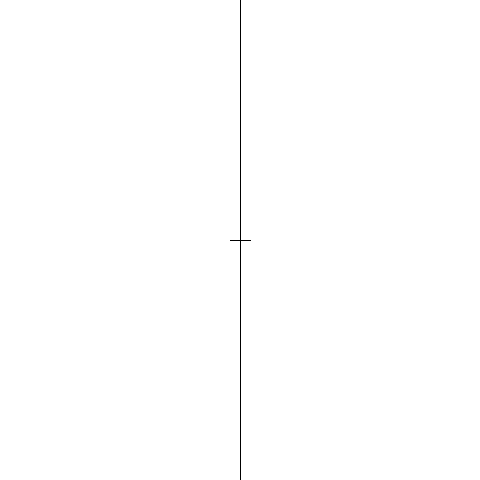
10 jul. 2012 - Subido por Jose Alfonso Hernando
Con las matematicas vorticiales puedes explicar absolutamente todo lo que hay en el universo. http ...
5 abr. 2011 - Subido por Alonzo Typer
Tecnologia Laser basada en las Matemáticas de Marko Rodin.
4 jun. 2016 - Subido por LosApuntes
Determino una medida que no se había encontrado, la del Punto de Unidad Primordial del Sistema de Marko ...
11 feb. 2017 - Subido por Ivan Brither
Matematicas Vorticiales. Ivan Brither. Loading ... 1ro Universo TAO Marko Rodin y Nassim Haramein ...
21 mar. 2019 - Subido por RedPill
Nesse vídeo eu mostro a relação do números 3,6,9, com o novos estudos na matemática vórtex de Marko ...
20 jul. 2014 - Subido por Jose Alfonso Hernando
Son las Matemáticas vorticiales, vortex based mathematics (VBM), basadas en ... en el numero phi, Su ...
22 sept. 2017 - Subido por José Antonio García
MATEMÁTICAS VORTICIALES 1: CONTROL (GSP-I 13) ... An Introduction to the Rodin Coil and Vortex Based ...
1 ago. 2013
Marko Rodin ha encontrado la fuente del constante “spin” o giro del ... Con la introducción de Vortex-base ...
21 mar. 2011 - Subido por nicteha19
Las matemáticas vorticiales de Marko Rodin, el camino hacia la ... Mark Rodin explica las utilidades de las ...
Freemasons in Venice and the Church of Saint Mary Magdalene
Mysteries & Legends

Freemasons in Venice and the Church of Saint Mary...
Venice, an ever magic and mysterious city, was already in the 18th century the centre of an influential Freemasonry fraternity, whose members also included the famous adventurer Giacomo Casanova.
Here, the Freemasonry fraternity was so powerful and rich that they had a church built following the Freemasonry doctrines – the church of Saint Mary Magdalene in Cannaregio.
A few components of the Baffo family, affiliated to the Freemasonry in Venice, contracted the architect Tommaso Temanza, also a member of the fraternity, to build the ‘Freemasonry' church. Temenza designed a perfectly round building with a neo classic style and a symbol of the Freemasonry etched on the architrave of the main door – an eye inscribed within a circle and a pyramid with the writing ‘SAPIENTIA EDIFICAVIT SIBI DOMUM', a reference to the cult of the divine knowledge, which is at the base of the Freemason ideologies.
Temanza himself is buried inside the church and his headstone is decorated with a line and compasses, the most important symbol of the Freemasonry, as its members would define themselves as ‘builders'.
It is no surprise that this ‘Freemasonry' church is dedicated to Mary Magdalene, a mysterious figure, sometimes rejected by the church, beloved instead by the Freemasonry and its members who considered her a symbol of wisdom and the struggle against the obscurantism of the church.
Unfortunately, this church is not open to visitors but if the unusual places of Venice are the ones that interest you the most, contact us! We will create an unforgettable personalized tour in Venice just for you in collaboration with Francesca, the editor of this popular section.
https://www.venetoinside.com/hidden-treasures/post/freemasons-in-venice-church-saint-mary-magdalene/
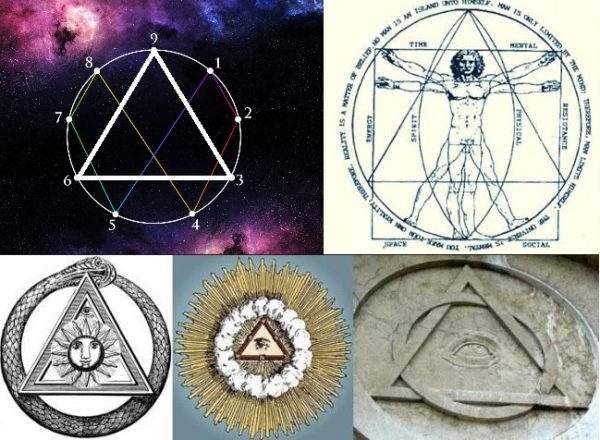
|
|
|
|
Réponse |
Message 135 de 139 de ce thème |
|
|
13/5 (PRIMERA APARICION DE FATIMA)-8/8 (LION S GATE))=88 DIAS EXACTOS
13/5-31/5=19 DIAS
JUNIO=30 DIAS
JULIO=31 DIAS
AGOSTO=8 DIAS
19+30+31+8=88 DIAS EXACTOS
INCLUSO EL PERIODO FATIMA 13/5-13/10=153 DIAS=JUAN 21:11=VESICA PISCIS=OJO DE GATO
DE TERROR
|
|
|
|
|
|
|
Réponse |
Message 136 de 139 de ce thème |
|
 Vesica piscis Vesica piscisTAURO/TORO/PLEYADES/7 COLINAS DEL VATICANO
 Fermentation - nigredo - bread and wine of Christ  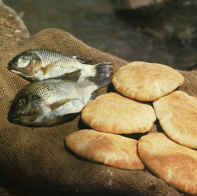 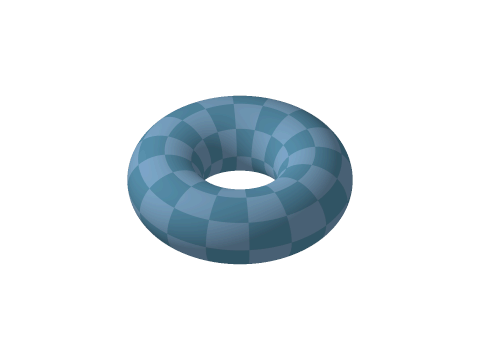 La vesica piscis (vejiga de pez en latín) es un símbolo hecho con dos círculos del mismo radio que se intersecan de manera que el centro de cada círculo está en la circunferencia del otro. Esta forma se denomina también mandorla (que significa "almendra" en italiano). Era un símbolo conocido en las antiguas civilizaciones de Mesopotamia, África y Asia.
CATOLICO/CAT-OLICO/CAT-EDRAL/CAT/GATO-EL OJO DEL GATO TIENE LA MISMA FORMA QUE LA DEL SEXO FEMENINO "VESCICA PISCIS"
|
13/5 (PRIMERA APARICION DE FATIMA)-8/8 (LION S GATE))=88 DIAS EXACTOS
13/5-31/5=19 DIAS
JUNIO=30 DIAS
JULIO=31 DIAS
AGOSTO=8 DIAS
19+30+31+8=88 DIAS EXACTOS
INCLUSO EL PERIODO FATIMA 13/5-13/10=153 DIAS=JUAN 21:11=VESICA PISCIS=OJO DE GATO
DE TERROR
|
|
|
|
|
|
|
Réponse |
Message 137 de 139 de ce thème |
|
|
|
|
Réponse |
Message 138 de 139 de ce thème |
|
|
|
|
Réponse |
Message 139 de 139 de ce thème |
|
|
|
 Premier Premier
 Précédent
125 a 139 de 139
Suivant Précédent
125 a 139 de 139
Suivant
 Dernier
Dernier

|
|
| |
|
|
©2025 - Gabitos - Tous droits réservés | |
|
|

